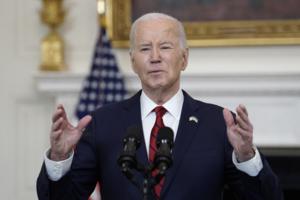Business
/ArcaMax

'The bane of retail.' To prevent theft, many big chains now lock up all kinds of merchandise
Detergent and deodorant, toothpaste, the entire shampoo aisle.
"It's all locked up," Corey Potter sighed, describing shelves encased behind security glass at a Target near her home in Los Angeles' Echo Park neighborhood. "I hate it."
Potter recalled once waiting 15 minutes for an employee to unlock a case at another Target location. These days...Read more

After hiring bonanza, tech workers now grapple with layoffs and disillusionment
Lisa Mabley was laid off a year ago from her job as a software engineer at a Twin Cities software company. Over the course of five months, she sent her résumé to nearly 300 companies.
She received just two offers at the end.
"The one that I did not accept has (since) had layoffs," said Mabley, who lives in Minneapolis. "If I had taken the ...Read more

The first big-rig hydrogen fuel station in the US opens in California
OAKLAND, California — The first commercial hydrogen fuel station for big-rig trucks in the U.S. is up and running at the Port of Oakland, a baby step toward what hydrogen proponents see as a clean new future for long-haul trucking.
The small station, now serving 30 hydrogen fuel-cell trucks, could mark the start of a nationwide network for ...Read more

Auto review: The Genesis G90 is cool just sitting in your driveway
OAKLAND COUNTY, Michigan — Luxury cars are becoming Brookstone gadget stores on wheels. Who needs to drive them? They’re just fun to play with.
Take the 2024 Genesis G90 sitting in my driveway.
With the key in my pocket, I walked up to the Genesis and it rolled out the red carpet. Make that lit carpet. A Genesis logo splashed on the ground...Read more

Auto review: 2024 BMW X6 is nothing short of stunning
The luxury midsize coupe is becoming increasingly popular in the consumer market, and BMW is easily the leader of the pack with its X6. Featured in Grasso's Garage this week is the BMW X6 xDrive40i, adorned in Aventurin Red Metallic — a fiery red/orange metallic hue that is a stunning display of beauty, at least to my eyes.
Equipped with an ...Read more

They all started companies. Some from wheelchairs
ATLANTA -- The entrepreneurs who arrived for the awards ceremony in a vast Cobb County ballroom wore tuxedos and gowns, suits and vibrant colors. One woman sported an eye patch with a sparkly skull and cross bones, like a glam pirate.
Some rolled in on wheelchairs, relied on canes, or covered their feeding tubes with their evening wear.
...Read more
Room & Board transfers ownership to employees with stock plan
Minnesota-based Room & Board has given its employees a seat at the table and transitioned the furniture company to an employee stock ownership plan.
The move provides Room & Board's 1,100 employees, who are mostly showroom salespeople, with financial stakes in the retailer.
"Our 1,100 staff members have been key to our success," said Bruce ...Read more

Electric vehicle 'workforce hub' coming to Michigan, White House says
WASHINGTON — Michigan will be among four new "workforce hubs" designated to help prepare workers for new manufacturing jobs, the White House said Thursday. The Michigan hub will focus specifically on electric vehicles.
The effort — a collaboration between federal and state agencies — is meant to train or retrain workers through ...Read more

California bill that could change how companies insure, renew policies moves forward
A bill that would require insurers to factor in wildfire protection efforts when determining whether to cover properties moved forward Wednesday, despite concerns from lawmakers and strong opposition from insurance companies.
Sen. Josh Becker, a Democrat who represents the Menlo Park area, said during a hearing that the proposal will help ...Read more
AI demand leads to Microsoft sales, profit beating expectations
Microsoft Corp.’s quarterly sales and profit climbed more than projected, lifted by corporate demand for the software maker’s cloud and artificial intelligence offerings.
Revenue in the third quarter, which ended March 31, rose 17% to $61.9 billion, while profit was $2.94 a share, the company said in a statement Thursday. Analysts on ...Read more
Korean shipbuilder agrees to a deal that could bring more jobs to Philadelphia
The world's largest shipbuilder, HD Hyundai Heavy Industries Co. Ltd. of Ulsan, South Korea, has signed a deal to seek U.S. government shipbuilding and maintenance contacts in alliance with Philly Shipyard Inc., which employs around 1,000 at the former Philadelphia Navy Yard site in South Philadelphia.
An agreement to "explore a potential ...Read more

California battery storage increasing rapidly, but not enough to end blackouts, Gov. Newsom says
Gov. Gavin Newsom said Thursday that California continued to rapidly add the battery storage that is crucial to the transition to cleaner energy, but admitted it was still not enough to avoid blackouts during heat waves.
Standing in the middle of a solar farm in Yolo County, Newsom announced the state now had battery storage systems with the ...Read more

'Net neutrality' to return under narrowly approved FCC rule, reversing Trump-era policy
The Federal Communications Commission has approved a rule which will reclassify broadband internet as a telecommunications service subject to federal oversight, reestablishing the so-called “ net neutrality” policy done away with under the Trump Administration.
In a 3–2 vote taken Thursday, the nation’s top communications regulators ...Read more
Micron gets combined $13.6 billion grant, loan for chip plants
The Biden administration chose Boise, Idaho-based Micron Technology for a $6.1 billion federal grant and $7.5 billion loan to build factories where memory chips would be manufactured, the latest award meant to drive domestic production of vital technology.
Micron will build one factory in Clay, N.Y., and another in Boise using the funds from a ...Read more

DHL to pay Chicago-area drivers $8.7 million in EEOC racial discrimination settlement
DHL has agreed to pay $8.7 million to resolve a long running lawsuit brought by the Equal Employment Opportunity Commission alleging the delivery company discriminated against Black workers in the Chicago area.
The EEOC accused the company of assigning Black workers to routes in neighborhoods with higher crime rates, segregating Black and white...Read more

US economy slows and inflation jumps, damping soft-landing hopes
U.S. economic growth slid to an almost two-year low last quarter while inflation jumped to uncomfortable levels, interrupting a run of strong demand and muted price pressures that had fueled optimism for a soft landing.
Gross domestic product increased at a 1.6% annualized rate, below all economists’ forecasts, the government’s initial ...Read more

Mortgage rates climb for a fourth week to reach 7.17%
Mortgage rates in the U.S. increased for a fourth straight week.
The average for a 30-year, fixed loan was 7.17%, up from 7.1% last week, Freddie Mac said in a statement Thursday.
House hunters looking to land a deal during the typically busy spring season are having to dig deeper to afford a purchase. Borrowing costs have climbed fairly ...Read more

Toyota is investing $1.4 billion to build another all-electric SUV in US
Toyota Motor Corp. is moving ahead with plans to manufacture and sell more electric vehicles in the U.S. by investing $1.4 billion at a plant in Indiana, the Japanese carmaker’s second such announcement this year.
The Princeton, Indiana, facility — which currently makes four gas and hybrid models — will add an unnamed all-electric, three...Read more

Childcare costs 'more than a mortgage' per kid, forcing Philly parents to make tough choices
The Salovin family pays $26,000 a year for childcare for their two daughters.
For them, it’s a worthwhile expense, knowing their 1- and 4-year-old girls are at a licensed facility and they can both stay in the workforce.
But even the Delaware County, Pennsylvania, couple — who work in health-care administration and pharmaceuticals — is ...Read more

Can Colorado cities prevent thousands of apartments from losing affordability protections?
Nine years ago, one of Silverthorne, Colorado’s few income-restricted housing properties was sold to a private firm. The sale — at a price that was double the property’s assessed value — raised worries in the high-cost mountain community that the new owner of the Blue River Apartments might lift rent caps that had kept its 78 units ...Read more
Popular Stories
- Childcare costs 'more than a mortgage' per kid, forcing Philly parents to make tough choices
- US economy slows and inflation jumps, damping soft-landing hopes
- Mortgage rates climb for a fourth week to reach 7.17%
- Can Colorado cities prevent thousands of apartments from losing affordability protections?
- Toyota is investing $1.4 billion to build another all-electric SUV in US





